Seasonal migrant workers in Scottish agriculture: research report
Outlines the main findings of research into seasonal migrant workers in Scottish agriculture, including: their number and demographics; the experiences of employers and seasonal migrant workers; and the long-term viability of this sector.
5. Workers Findings
Over half of the workers who responded were men, however there was a high prevalence of female migrant workers (42% of respondents).
Respondents were a wide range of ages, from 18 to 62, with an average age of 33 years. Around half of workers completing the survey were returnees (53%) and around half (47%) were non-returnees.
Two out of five found their employer through a friend or family member. Less than a fifth saw an advert/social media/website to find their current employer.
Most workers were employed in the fruit sector (81%). Under one in ten (8%) were responsible for supervising other workers.
Respondents spent 43 hours working in a typical week and were paid on average £10.22 per hour. Just over half (53%) were happy with the number of hours they work whilst 46% would prefer more hours. On average, seasonal migrant workers paid £62 per week for their accommodation, although costs ranged from £30 to £300. For nine out of ten workers, accommodation was arranged by their employer.
There are challenges to every current method of collecting data on the number of seasonal migrant workers in Scottish Agriculture in a given year. Since 2017 estimates from various sources have ranged from 7,500 to 9,255. Data from the Scottish June Agricultural Census also shows a downward trend in the number of seasonal workers since 2019. This is corroborated by accounts from the National Famers' Union for Scotland who say the decline is due to (i) retraction in the area of vegetable crops, (ii) lower returns and higher costs for fruit and vegetables, and (iii) the Ukraine war affecting availability of labour. Modelling in this research estimates that, including EU Settled status workers, there were up to 6,570 seasonal workers in Scottish agriculture in 2021, but there are limitations to the sample size used in forming this estimate.
5.1 Introduction
This chapter includes findings from primary research with seasonal migrant workers. Research aims addressed include:
- Experiences of agricultural seasonal migrant workers
- Long-term prospects and viability of the industry
Please see Appendix L for Number and demographic qualities of agricultural seasonal migrant workers in the achieved sample. The survey achieved 439 returns. A total of three interviews were completed and are presented in the form of pen portraits, highlighting the lived experience of these individuals.
5.2 Estimate of the number of seasonal migrant workers
Having an accurate measure of the number of seasonal migrant workers is critical to being able to respond the needs of both employers and workers and ensuring the sustainability of the sector. However, due to data limitations, arriving at a definitive figure is challenging.
The June Agricultural Census in Scotland can provide data on numbers of casual and seasonal staff and estimates of migrant labour (person working days) used on holdings (see table 5.1), but as Thomson et al (2018) explained, "it does not readily permit estimation of the number of seasonal workers in Scottish agriculture due to, for example: seasonal employment being for different durations, or some individuals working on more than one holding in a season. The seasonal profile of labour within the Scottish soft fruit sector is likely to peak from May to August but knowledge gaps prevent robust assessments of the true extent of migrant workers on Scottish farms."
| Year | Males | Females | Total | Migrant labour (person working days)(1) |
|---|---|---|---|---|
| 2011 | 4,471 | 2,474 | 6,945 | 410,409 |
| 2012 | 4,353 | 2,139 | 6,492 | 546,675 |
| 2013 | 4,539 | 2,213 | 6,752 | 492,607 |
| 2014 | 4,410 | 2,256 | 6,666 | 350,566 |
| 2015 | 4,667 | 2,171 | 6,838 | 459,801 |
| 2016 | 4,389 | 1,961 | 6,350 | 429,741 |
| 2017 | 5,734 | 2,515 | 8,249 | 659,138 |
| 2018 | 5,628 | 2,587 | 8,215 | 710,381 |
| 2019 | 5,829 | 2,751 | 8,580 | 534,327 |
| 2020 | 5,559 | 2,679 | 8,238 | n/a |
| 2021 | 5,411 | 2,592 | 8,003 | 394,229 |
Source: Table 8a. Final Results of the June 2021 Agricultural Census together with June results for the years 2011 to 2020 for comparison.
(1) migrant workers are workers that are not UK nationals. Improved data available in 2017. Impact of changes to Census due to COVID-19 resulted in insufficient data returned to produce estimate for 2020. For more information, please see accompanying methodology report.
Table 5.1 shows that in 2021, the Scottish June Agricultural Census estimated 8,003 casual and seasonal workers but this includes both migrant and non-migrant workers. Migrant labour in person working days gives another indication but is susceptible to inaccuracies and double counting. With that said, evidence from employers in this report (See section 4) and elsewhere suggests migrant workers make up the vast majority (~90%) of the seasonal workforce.
While it is recognised there are limitations with using the casual and seasonal staff figures from the June Agricultural Census in Scotland, in conjunction with other sources, it does provide an indication of trend. The number of casual and seasonal staff fluctuated between 6,350 and 6,945 until 2017 when it rose to 8,249 and increased to 8,580 in 2019. Then in 2020 and 2021 the number of casual and seasonal staff has fallen, and in 2021 was estimated to be 8,003.
Accounts by NFUS confirm the downward trend seen in the June Agricultural Census in Scotland and suggest the number may be lower in 2021, due to retraction in the area of vegetable crops, lower returns and higher costs for fruit and vegetables, and the Ukraine war affecting availability of labour.
Through this project's research advisory group researchers were made aware of another recent estimate. The data was not published nor made available to researchers. However, the approach and its limitations have been shared as follows. In 2021, Scottish Government's Science and Advice For Scottish Agriculture (SASA) division compiled public health data collected during the Coronavirus (COVID-19) pandemic and arrived at an estimate of between 7,500-9,000 seasonal migrant workers in Scottish agriculture during any one season. The figure was compiled using information from the UK Border Force passenger location forms collected at all UK ports of entry (i.e. sea ports and airports) where the passenger's final destination was a Scottish farm and also from the number of Coronavirus (COVID-19) tests being returned. The limitation to this estimate and the reason for it being presented as a range is that there could be double counting.
The 2018 'Farm Workers in Scottish Agriculture' report conservatively estimated that there were 9,255 seasonal migrant workers engaged in Scottish agriculture during 2017 (including 900 employed directly by labour providers). Thomson et al (2018) also list the following challenges to estimating the figure:
"A key challenge in estimating the extent of seasonal migrant labour use in Scotland relates to complexities surrounding: (i) variance in the proportion of labour being directly employed on farms compared to that indirectly employed through labour providers; (ii) incomplete estimates of seasonal migrant labour provision in administrative databases; (iii) farm businesses leasing their land to specialist growers who undertake all of the farming activity (which does not appear in official databases but needs to be considered to prevent a gross overestimation); (iv) the transitory nature of some migrant labour – working on multiple farms."
To summarise, since 2017 estimates from various sources on the number of seasonal migrant workers have ranged from 7,500 to 9,255.
In this report, econometric macroanalysis modelling techniques were used to explore if there was an appropriate technique which could be used to model the number of agricultural seasonal migrant workers. Different approaches were used to model an estimation of the number of seasonal migrant workers using data from the Employer Survey and some utilised data from the Scottish June Agricultural Census. The techniques described in Appendix G resulted in a number of estimates. Different techniques arrived at different estimates. Estimates vary between 2,932 and 6,570 seasonal migrants working in Scottish agriculture in 2021. When including EU Settled status workers the uppermost modelling estimate is 6,570 seasonal migrant workers. Due to the nature of the research, there are limitations to the sample size used in forming the estimates of this methodological approach.
It is clear from these findings that without comprehensive data that is collected the same way each year, the Scottish Government cannot establish trends and connect world events or UK migration schemes to any change in numbers.
5.3 Worker Survey
Worker experiences of recruitment
Two out of five workers (40%) found their employer through a friend or family member. Around a quarter (24%) used a recruitment company in their own country. Less than a fifth (17%) saw an advertisement/social media/website to find their current employer (figure 5.1). This finding bolsters the importance of word of mouth and recommendations in encouraging workers to come to Scotland (see section 4).
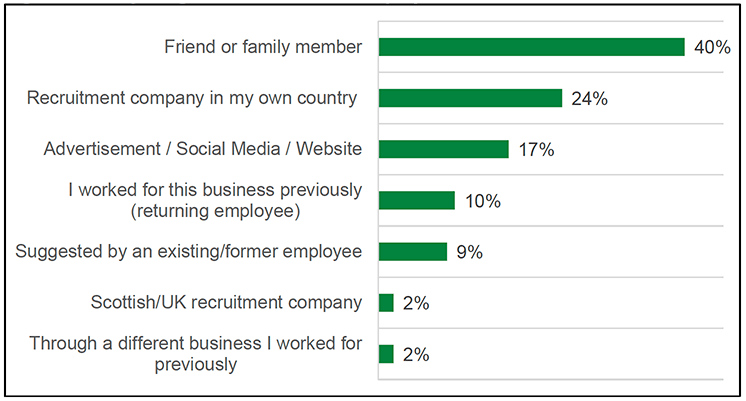
Q9. How did you find your current employment?
Base: n=393
The vast majority of seasonal migrant workers did not need to pay a recruitment fee to find seasonal work in the UK (94%). The most common ways to fund travel to Scotland or the UK were through the use of savings (60%) and credit cards (45%). Around a fifth (21%) of workers borrowed money from family or friends (figure 5.2). It is interesting to note that a half of workers (50%) had come to Scotland based on borrowing loans or credit.
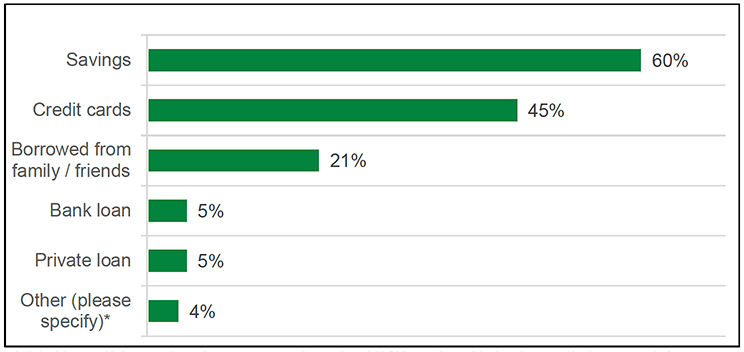
Q11. How did you fund your travel to the UK/Scotland? (select all that apply)
Base: n=396
The majority of seasonal migrant workers had either EU settled status (23%) or pre-settled status (19%). Other routes include the Tier 5 visa (17%), the seasonal workers programme (10%) and Student visa with work option (3%). There were three routes for people from Ukraine to come to Scotland, including the Homes for Ukraine Scheme, Ukraine Family Scheme and Ukraine Extension Scheme which accounted for 12% of the overall entry routes (figure 5.3).
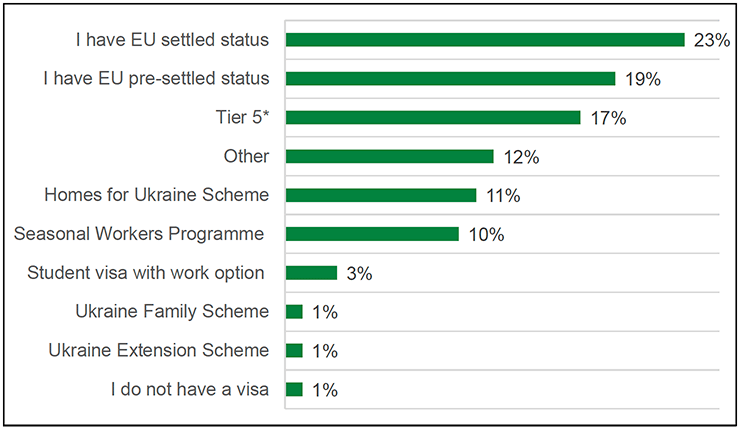
Q2. Which visa scheme are you using in Scotland?
Base: n=391
Experiences in Scottish agriculture as a seasonal migrant worker
Just over a third of seasonal migrant workers had not worked in agriculture before. This was the first year a third (38%) of seasonal migrant workers were employed in agriculture in any country. Just under half (47%) had worked in agriculture in Scotland for the first year.
These results differ by sex. Typically, females were more likely to be returnees than males. Over a third of males (37%) were working in Scottish agriculture for the first year whereas only a quarter of females (26%) were in Scottish agriculture for the first year.
Given the desire expressed by employers for workers to return year on year (see section 4) it is interesting to find just over half (53%) were returnees and just under half (47%) were non-returnees (see figure 5.4).
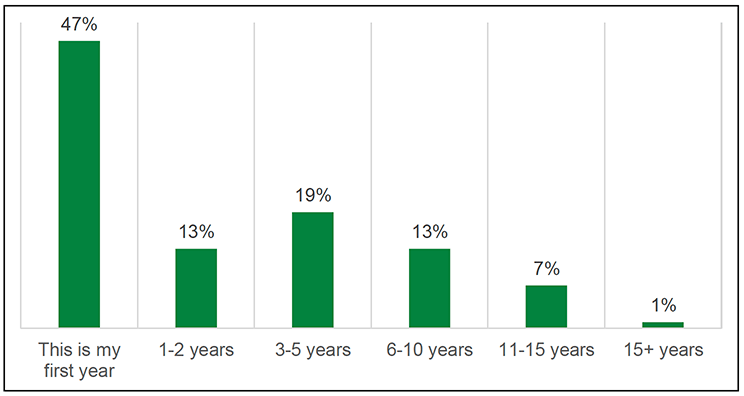
Q8. For how many years have you done the following?
Base: n=280
The highest proportion of returnees have between 3-5 years of experience within Scottish agriculture (19% of all seasonal migrant workers). This is over a third (36%) of all returning migrant workers to Scottish agriculture.
Some seasonal migrant workers had worked across more than one sector in agriculture within the year (12%). As described in the employer and stakeholder interviews (see chapter 4), most workers were employed in the fruit sector (83%). Indeed, none were involved in pig farming or dairy.
The activities conducted by seasonal migrant workers were diverse, and workers selected multiple activities in response to this question. Just over a third were involved in grading fruit, vegetables, or potatoes (34%) or general maintenance (35%). Processing or packaging farm products (29%) and caring for growing plants (28%) were also common activities.
Under one in ten (8%) were responsible for supervising other workers. This finding relates to what was observed during interviews with employers - that supervisory roles were often performed by seasonal, non-migrant workers or seasonal migrant workers returning to a farm (see chapter 4). Indeed, the seasonal migrant workers in Scotland for their first year carried out a different range of tasks compared to those with any previous experience (figure 5.5). Caring for growing plants was the most common task for those who are working with Scottish agriculture for the first year (40%) compared to those with any experience (26%). Workers with at least one previous year of experience were more likely to be responsible for grading fruit, vegetables or potatoes (39%) than those working in Scottish agriculture for the first year (26%).
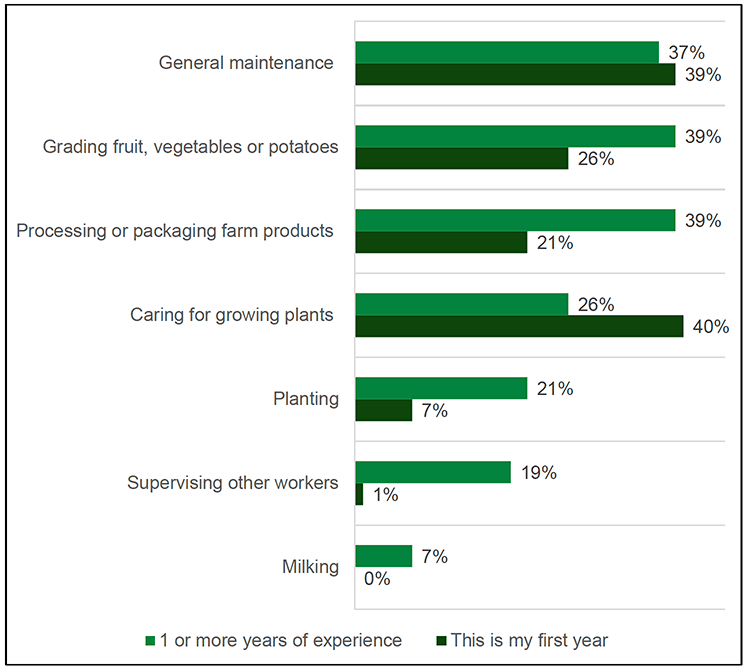
Q14. In your current job, which of the following activities do you carry out?
Base: n=140 1+ years' experience, n=126 first year
Satisfaction
The survey asked a number of questions relating to satisfaction levels with various elements of work and living conditions. It should be noted that whether individual workers regard these as satisfactory will be subject to their own perspectives. The analysis shows overall findings, and results from analysis looking for difference between different groups.
The vast majority (96%) of seasonal migrant workers were satisfied, including 38% very satisfied, with the working conditions on the farm. A small minority (5%) were dissatisfied.
Just over half (53%) of seasonal migrant workers were happy with their number of hours they work whilst 46% would prefer more hours than they currently work. Only 1% would have preferred to work fewer hours (figure 5.6). This finding relates to the employer and stakeholder feedback that workers may not be able to work the number of hours they desire.
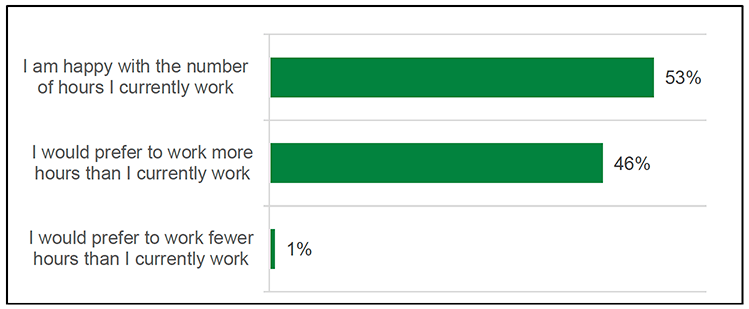
Q16. Please indicate which of the following statements you most agree with
Base: n=393
Females are more likely to be happy with the number of hours they currently work (58%) than males (48%). Conversely, males were more likely to prefer to work more hours than they currently work (51%) than females (40%).
Typically, migrant workers from Kazakhstan would prefer to work more hours than they currently work (74%) as would those from Uzbekistan (67%). People from Poland (89%) and Romania (84%) are more likely to be happy with the number of hours they currently work (see figure 5.7).
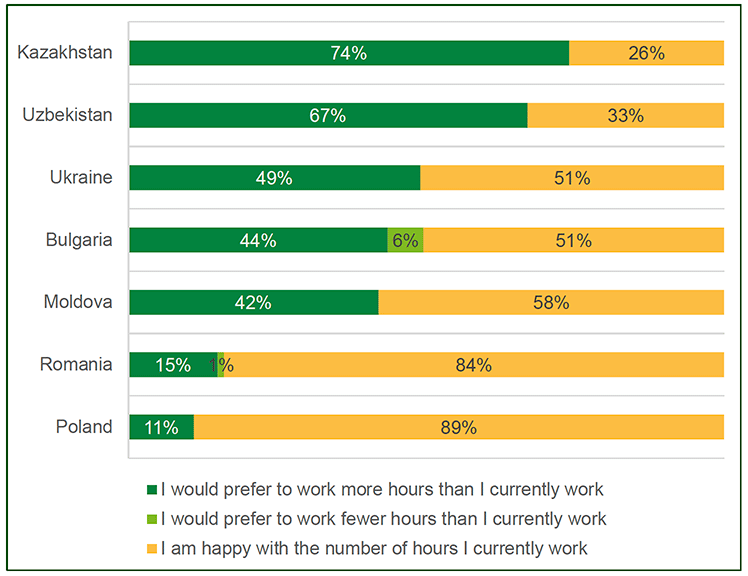
Q1. Please select your home country
Q16. Please indicate which of the following statements you most agree with
Base: n=314
On average, seasonal migrant employees spent 43 hours working in a typical week and got paid £10.22 per hour. This ranges from a minimum of £4.80 per hour to a maximum £15 per hour.
Workers were asked about benefits provided in addition to their salary. Over three quarters (77%) were provided with transport between the workers' accommodation and where they worked in addition to salaries. Around one in ten (11%) were provided with accommodation in addition to salaries. Furthermore, 9% were provided with power costs by employers in addition to salaries.
On average, seasonal migrant workers paid £62 per week for their accommodation. The cost of accommodation ranges from £30 to £300 per week. Most seasonal migrant workers (84%) lived in a caravan on the farm where they worked. Other types of accommodation included housing on the farm where they worked (9%), private rental housing (3%) and Homes for Ukraine Scheme hosts (3%).
Three quarters (74%) of seasonal migrant workers had accommodation arrangements in place before they came to Scotland. Some were unsure when the accommodation arrangements were made (11%) whilst the remainder did not have accommodation arrangements in place (15%).
Employers were typically responsible for arranging accommodation (90%) however a small minority of seasonal migrant workers had found their own accommodation (4%). Friends or family (3%) also helped some with their accommodation arrangements while recruitment agencies helped 2%. This result indicates that responsibility for arranging accommodation largely rests on employers.
The majority (87%) were satisfied with accommodation (27% very satisfied, 60% satisfied) while 13% were dissatisfied with their accommodation (see figure 5.8).
Satisfaction did not depend much upon the type of accommodation, although satisfaction with caravans on farms was 84%.
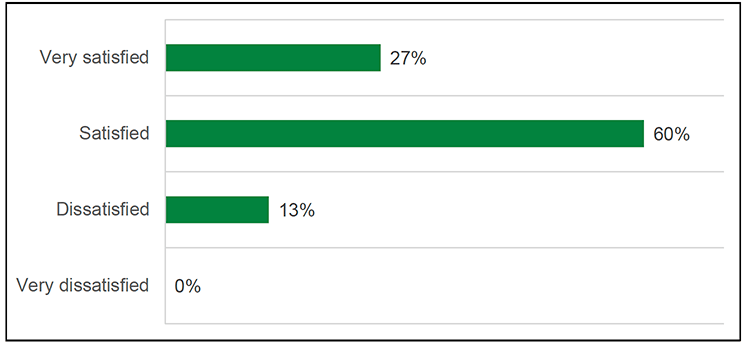
Q24. How satisfied are you with this accommodation?
Base: n=390
Satisfaction levels differed between people from different home nations. People from Romania had highest rates of satisfaction with their accommodation and Kazakhstan the lowest (see figure 5.9).
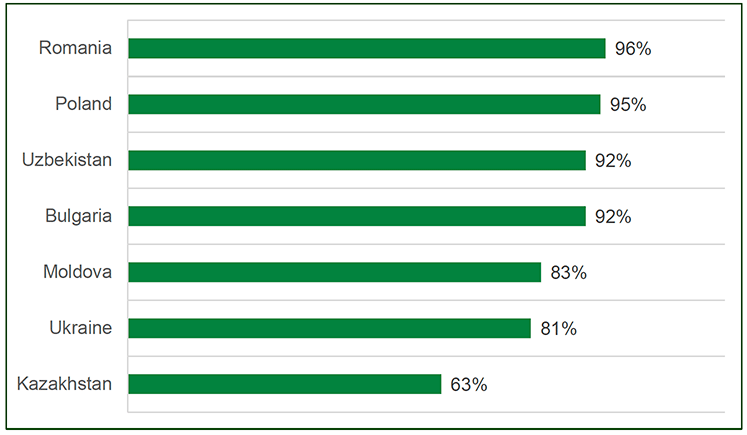
Q1. Please select your home country
Q24. How satisfied are you with this accommodation?
Base: n=312
Long-term prospects and viability of the industry
This section starts by presenting findings on the motivations for workers coming to Scotland. Next, challenges of working in seasonal migrant workers are shared. Next, positive aspects are summarised. The section finishes by presenting data on intentions to return to work in Scottish agriculture.
Motivations
Seasonal migrant workers reflected upon reasons for coming to Scotland in order of importance. A higher rate of pay/income levels than in my home country was the most influential reason for 86% of seasonal migrant workers (figure 5.10).
One in ten (11%) chose their top motivation as the opportunity to learn or improve their English while fewer (2%) selected travelling to meet with friends or family working in Scotland as their top motivation (2%).
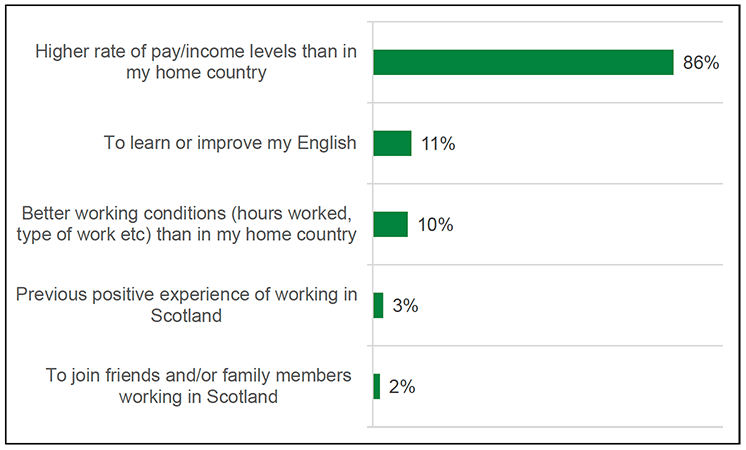
Q12. What are the main reasons you came to work in Scotland? Please rank order of importance where 1 is most important and 5 is least important.
Base: n=279
Challenges of working in seasonal agriculture in Scotland
Seasonal migrant workers faced challenges during their time working in Scottish agriculture (figure 5.11). The most prevalent challenge selected was missing family or friends (62%). This finding supports a future focus on well-being of workers and enabling workers to regularly communicate with friends and families.
Other notable challenges were costs of accommodation (15%), high workload/fatigue (13%) and isolation and distance to urban centres (11%). Encouragingly no seasonal migrant workers reported any delay in receiving wages, and very few (1%) with difficulty taking time off for holidays or illness.
Around a third experienced challenges around language barriers (31%). This indicates that language provision and support could be improved. Looking further into these responses, this challenge was not limited to only those people with a self-described beginner level of English-speaking ability (see figure 5.12).
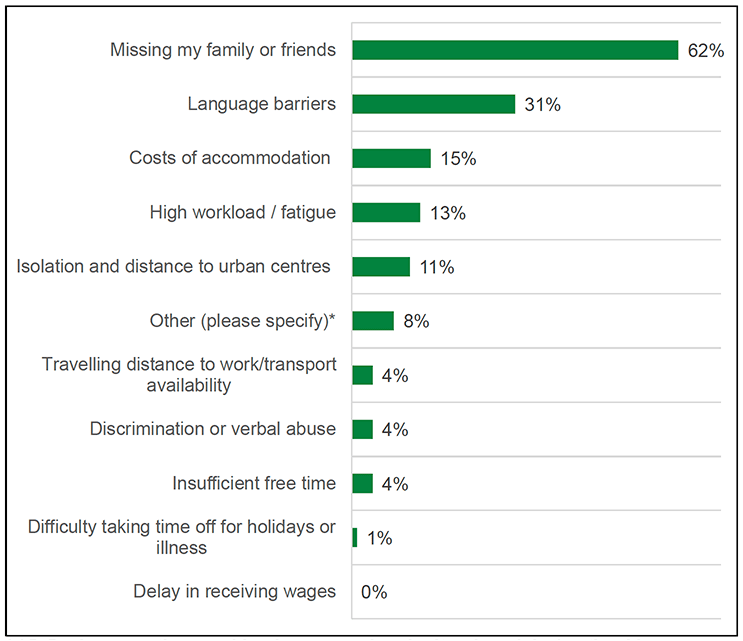
Q25. During your time working in seasonal agricultural work in Scotland have you experienced any of the following challenges?
Base: n=339

Q5. How would you describe the level of your English-speaking ability?
Base: n=98
In text responses expanding on their answers, a negative feature was a lack of nearby friends and family and the distance from home. Although a couple of respondents mentioned living and working on farms with their children or other family members, many talked about feeling homesick and missing their relatives. In line with this, a few workers felt there to be cultural differences with some co-workers who did not share their interests or hobbies:
"Interests do not coincide with Bulgarian and Romanian, especially in music"
Many respondents commented on the unpredictability of Scottish weather – namely, the rain and colder weather– and preferred the climate of their home countries.
A few respondents felt that they received a low rate of hourly pay for their work, while others noted that the (typically six month) time limitations posed by visa restrictions and/or the Seasonal Workers Programme had negatively impacted their overall experience of working in Scottish agriculture:
"The visa doesn't last very long, only six months"
A few workers were unsatisfied with the hours they work; some respondents were of the view that they were working too much, while others were not working as much as they would like. Others discussed a lack of free-time and a perceived monotony of tasks:
"Few hours of work, I would like 50-55 hours in a week"
The remoteness of some farms, especially those away from towns, cities, or other amenities, was also considered a disadvantage, and could be seen as isolating.
Respondents who paid towards accommodation mentioned the expensive cost of these, whilst others complained about accommodation conditions, including living in caravans and the colder temperature of these during the autumn and spring months.
The level of manual labour required from the work was considered to be a negative by some respondents. Indeed, some mentioned having back pain from working with low-lying soft fruit.
A few workers mentioned terms like 'discrimination' or 'unfairness' but did not provide further detail on the nature of this. However, many respondents emphasised in their written responses that they were happy with their experience and had no negative aspects to report.
Positive aspects of working in seasonal agriculture in Scotland
Seasonal migrant workers ranked the positive or beneficial aspects of working in Scottish agriculture from one to seven, where one is the most positive/beneficial and seven is the least positive/beneficial.
The most positive/beneficial aspect of working in Scottish agriculture was the ability to earn a good income, with over eight in ten selecting as most positive aspect (see figure 5.13).
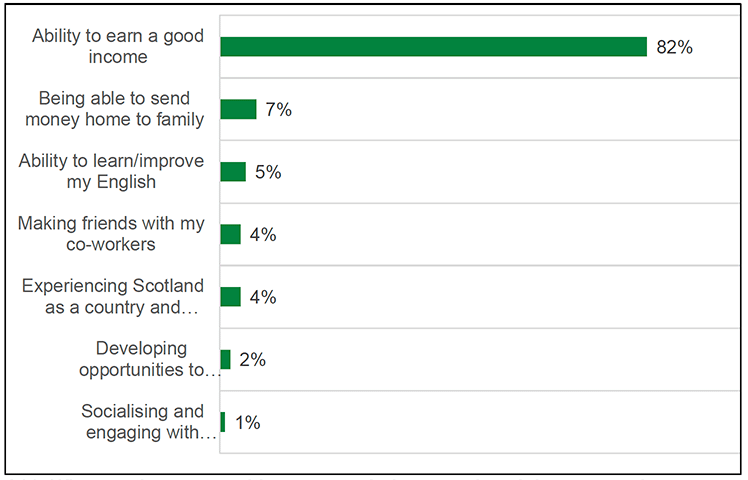
Q26: What are the most positive aspects during your time doing seasonal agricultural work in Scotland? (Please rank each answer from 1 to 7, where 1 is most important and 7 is least important to you)
Base n=200
Seasonal migrant farm workers expanded on these aspects in text responses. Phrases such as 'good vibes,' 'good atmosphere' and 'friendly people' were added. The experience of farm working, and living in Scotland more generally, had offered respondents great opportunities to find new friends and meet and interact with people of different backgrounds, nationalities and cultures:
"New experiences, friends, discovering a new culture and special people"
Many respondents had enjoyed experiences offered by the Scottish landscape, culture and people, and mentioned the politeness and friendliness of locals they had encountered. Workers also noted that the discovery of Scottish traditions and festivities had enhanced their experience. Several respondents appreciated Scotland's architecture and natural beauty and had enjoyed learning about, and visiting, Scottish landmarks and other sites of interests:
"Social integration in working environment, learning about Scotland landmarks. City infrastructure, Scottish nature."
"The opportunity to get to know a new country and to know and respect its traditions"
Similarly, others liked having 'leisure-time' or 'free-time' to relax, explore their surroundings or go on excursions. Such excursions could be organised by employers or by workers themselves:
"Organisation of leisure activities by the employer. Sea and nature!!!"
"Have travelled and went on a trip Shetland and around Great Britain"
Good relationships with employers and other co-workers were an important 'positive.' Many respondents praised the friendly and accommodating attitude of management towards workers and said they enjoyed working with, and learning from, others in their team:
"A friendly farm owner who was in constant contact with the workers."
A prominent positive feature of respondents' experiences was the high earning potential offered by seasonal agricultural work. The vast majority of respondents discussed having a 'Good salary,' 'Good pay' and 'Good wages for the work I do.' Others were happy to receive timely payments of fair wages and liked the potential to get paid extra based on performance. The income afforded by working in agriculture was summarised by one respondent who noted that:
"Agriculture brings a good income. To be able to do a lot, to learn new things and feel that you can is a very pleasant feeling, especially when you can earn!"
Others were pleased at being able to learn skills in and experience working in agriculture. A few respondents felt that it was versatile work experience, as they could transfer learned skills to other roles or scenarios. Seasonal agricultural work was also seen as positive where there were opportunities for training, career growth, self-improvement and learning something new. Others were positive about gaining extensive experience with agricultural machinery, cultivation and acquiring skills in the care and packaging of produce, such as soft fruits. Similarly, living in Scotland had led workers to learn the English language or improve their English-speaking abilities.
A few respondents said that they found certain aspects of working in Scotland more appealing than their own country, but tended not to give examples of these, other than pay:
"That I've earned slightly more money that I would have had in my country"
A small number of respondents felt that there were no positive features of their experience working in Scottish agriculture, writing that these "Do not exist."
Reflections on coming back to Scotland
Only a small minority (4%) did not intend to return to Scotland for future seasonal agricultural work (see figure 5.25). The majority were likely to return (89%). Reasons for the small minority not planning to return to Scottish agriculture included ease of future access to UK (20%), having a permanent job arranged (19%) and the cost of living (14%) (see figure 5.14).
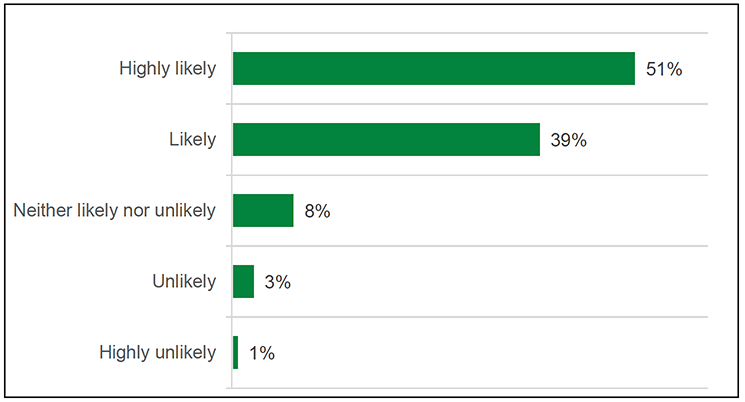
Q27. Which of the following best represents your view on whether you will return to Scotland for future seasonal agricultural work?
Base: n=383
Respondent views on whether they would return to work in agriculture in Scotland were mixed. For clarity, text responses have been summarised regarding 'Yes,' 'No' and 'Maybe' categories below.
Many of those who stated they would like to return to agricultural work in Scotland did so because they have enjoyed living and working here, with some re-affirming that they like Scotland's culture and traditions:
"Yes. Interesting culture and polite people"
The vast majority centred around the perceived 'better pay' they receive in Scotland, higher earning potential and the pursuit of 'a better life' than that on offer in their home countries. Some wished to return to improve their English-speaking abilities, while others felt that the Scottish agricultural sector offered job security and stability. The ability to save was also seen as advantageous, with some respondents outlining their motivations to return to work in Scottish agriculture in order to reach a goal, such as buying a house for themselves and their families:
"Yes, it is easier to save while on the farm, you don't have to deal with city temptations"
Enjoyment of working in, and building experience of, the agricultural sector was another key motivating factor for return, whilst other respondents wished to progress upon return and take on new roles, such as that of supervisor:
"Yes, I would return only as a supervisor. Growth is very important for me"
Others stated that they would return if they could not find a job based on their newfound experience in their home country.
Those who did not plan to return to work in Scottish agriculture instead wanted to move on to work in another sector or speciality, often in their home country, and saw agricultural work as a 'fallback option':
"I would like to move on and find a job in my speciality. In extreme cases, I will return to agriculture"
Several respondents said that they dislike agricultural work – particularly the levels of manual labour and physical strength required – and mentioned for example, the negative health impacts of bending and heavy lifting.
Some respondents who were unsure whether to come back to work in agriculture in Scotland again wrote that their return would be dependent on their visa status:
"I will come back but I have restrictions as I don't have status, I am on a visa"
A few respondents would take pay levels into consideration when deciding whether to work in Scottish agriculture again. One respondent would return if they were invited to do so by their farm/employer, while another noted that the labour intensiveness of agricultural work would influence their decision.
5.4 Workers Interviews
These pen portraits provide an insight into the lived experience of individuals working as seasonal migrant workers in Scotland. These are based on interviews with three women who worked on different farms. Two worked on fruit farms and one on a vegetable farm. One of the women shared her experience as a first timer working on a Scottish farm. The other two were returnees.
Silvia
Silvia, in her mid-40s, had returned to work on the same farm for the past three years. As a native Bulgarian speaker, she could also speak English at beginner level. She was initially motivated to work in Scottish agriculture after hearing her friends talk about their experiences and thought it would help to alleviate the financial struggles she was facing at the time.
She has not used recruitment agencies, and instead found the farm she works on through recommendations and her own online research. Silvia had found her established relationship with the farm helpful in arranging return, as she contacted them directly to check if there was work available. Other than travel costs, which she paid for herself, her returns have not incurred other expenses, such as recruitment fees.
She had good awareness of her tasks – which include the sorting and harvesting of vegetables – and knew what to expect upon each return.
While Silvia was expecting to work more hours, she found her working hours of approximately 48 per week to be sufficient. Silvia noted that working conditions were good and her pay of £9.50 was what she was told in advance. She also felt confident and able to freely discuss issues with permanent employees on the farm. She commended her employer for being responsive to requests for the living and working arrangements.
Over the years she has lived in shared caravan accommodation. In fact, this has been with the same group of women for three years. Though she initially felt that some of the furniture, such as the beds, were too small, she said the accommodation was pleasant, clean, and comfortable.
Silvia's employer had not offered any social activities during her stay, though she said this is largely due to COVID-19 precautions. She had regularly made use of local buses to travel into the nearest town or travelled with colleagues in their private vehicles.
Having not worked in agriculture anywhere but Scotland, Silvia was unsure of how it compares to other countries. She was keen to return to work in Scottish agriculture because her impression was that the earning potential was higher than other countries, including England. She would recommend her experience to others primarily for this reason.
Nicoleta
Nicoleta, in her mid-40s, had worked in Scottish agriculture for eight years, seven of which had been on the same farm. She was primarily motivated by her desire to come to Scotland, as well as the potential to earn more money than she could in Romania. Nicoleta speaks Romanian, and her time on the farm enabled her to become an advanced English speaker.
She initially found her employer through an agency in Bucharest, and also used advertisements and websites to find out about agricultural work in Scotland. Here, she saw a job opportunity where her and six others – including members of her family and close family friends – could stay and work together on the one farm.
Nicoleta had experience of running her family's land holding in Romania and was experienced in many aspects of agriculture prior to coming to Scotland.
Nicoleta stated that all of the information she received before coming to Scotland was correct and accurate. Nicoleta has not had to pay recruitment fees, though she does pay for her own travel costs.
Having worked on the same Scottish farm year on year, she has established strong relationships with her employer and other colleagues and spoke of them in her interview as her second family.
Nicoleta described her tasks on the farm as manageable. These tasks were mainly picking and grading soft fruit, like blueberries and strawberries. Again, she had good awareness of the types of tasks she may be asked to carry out, while her frequent returns to the farm have offered opportunities to build her knowledge and learn new skills.
She explained that her pay, £9.50 per hour, was clearly laid out and also met her expectations; she said she received a good bonus for her work. She was happy with the number of hours she worked, which she estimated as 42 hours per week.
She enjoyed staying with her daughter-in-law in caravan accommodation on the farm and found it homely where they were able to 'make it their own.' Nicoleta – and other workers on the farm – cooked for themselves and could obtain groceries by walking or getting the bus to nearby shops.
Occasionally, the owners of the farm provided catering for special events, such as in the summertime, offering the opportunity for employers and employees to eat together and socialise together. Nicoleta has formed friendships with workers of many nationalities – including those from Bulgaria, Ukraine and the Czech Republic – over the years.
Nicoleta had a less positive experience at the first farm she worked at during her first year in Scotland. She recalled how some employees were overly competitive and sought to take work from others. Her concern was with the negative atmosphere and tensions between workers, rather than any complaints with her employer. But as a result, she sought out a farm with a friendlier atmosphere and better working relationships the second year onwards.
As Nicoleta typically works at her current farm between April and October, she has also worked in other parts of the United Kingdom outside this period. For instance, she had a positive experience when working in a packaging house on a trout farm near London. Nicoleta also briefly worked in manufacturing at a factory in England, but realised she preferred to work outdoors.
Citing the reasons mentioned above, as well as what she saw as a higher earning potential in Scotland compared to Romania and other European countries, Nicoleta anticipated many returns to her current farm and was strongly considering a permanent move to Scotland.
Maria
Maria, in her late 20s, is from Ukraine. She described the shared aspiration her and her partner had to come to work in Scottish agriculture. This came about through recommendations from family members who had previously worked in Scotland and preferred it to working in England. Maria and her partner initially planned to achieve this aspiration through a UK-based recruitment agency and had started on the visa application process. Their plans were then affected when Russia invaded Ukraine in February 2022.
Maria was later contacted directly by a farm manager, who offered to sponsor her and her partner under the Homes for Ukraine programme and arrange their visas. The farm manager was keen to extend help to others in a similar situation and encouraged Maria and her partner to invite others who needed help and/or were in danger to join them at the farm.
The couple paid for their own travel costs, though their visa expenses were re-imbursed through the Homes for Ukraine programme. They also drew on their personal savings. Like others using the Homes for Ukraine programme, they were issued a £200 welcome payment, enabling them to complete their registration and reach their sponsor.
Before coming to work in Scottish agriculture, Maria watched online videos of agricultural work to gain insight into potential tasks she may have to undertake on the farm. Some of these videos gave her a negative impression – in terms of the difficulty of the work, effort required and weather conditions. However, on coming to Scotland she found her own tasks to be more manageable, and less challenging, than she was expecting.
Maria speaks her native Ukrainian and described her English levels as intermediate spoken. She felt that all of the information she received before coming to work in Scottish agriculture was clear and correct. Before travelling, she had good awareness of how much she would be working and earning. This was helped by documentation outlining pay and hours ahead of her arrival on the farm. Maria had also received a link to the farm's website, so she could see what the farm looked like and where it was in Scotland. She found this level of transparency reassuring.
Although Maria had not felt the need to make any complaints whilst on the farm, she knew of other workers who had done so. She framed this positively in that her colleagues felt comfortable making complaints or suggestions to specific points of contact on the farm. Her impression of the response to these suggestions was that the farm was responsive, open to feedback and quick to resolve issues.
Maria stayed in a caravan with her partner. She felt that it was spacious and had a good level of amenities, including indoor bathroom facilities. She did point out that some people of other nationalities working on the farm lived in 'four-person' caravans, and wondered whether their living situation might have been a result of checks required by the Homes for Ukraine programme. Apart from water, gas and electricity costs (which Maria paid for) any remaining accommodation costs were covered by her employer. She bought her own food but could use on-site facilities to cook. She also had unlimited use of on-site washing machines, with her own supply of detergent. Although Maria was initially tasked with picking and harvesting fruit in the fields, she was soon transferred to work in a facility for grading, processing and packaging. She estimated that she worked around 40 hours per week and was happy with that level. Maria was paid £9.50 per hour on the farm.
The farm housed a gym and games room which she enjoyed. Whilst her and the packaging facility team attended parties organised by the farm manager and firm owner, she was unsure as to whether field workers had similar social events.
Maria appreciated that the farm manager took the time to check in with workers and get to know them and had good relationships with the workers. She made many friends throughout her first year of working in Scottish agriculture – all of whom aim to return to the same farm next season – and Maria would recommend the experience to others.
5.5 Conclusion
Most of the results in this chapter were derived from the Worker Survey which achieved a large sample of responses from seasonal agricultural workers (439).
In terms of nationality, a fifth of respondents (21%) were from Romania, just under a fifth (18%) were from Bulgaria and 17% were from Ukraine.
Over half of the workers who responded were men, however there was a high prevalence of female migrant workers (42% of respondents).
Respondents were of a range of ages, from 18 to 62, with an average age of 33 years. Around half of workers completing the survey were returnees (53%) and around half (47%) were non-returnees. Returnees had most commonly worked previously in Scottish agriculture for around three to five years. Those who were in Scotland for their first time carried out a different range of tasks compared to those with any previous experience. Two out of five found their employer through a friend or family member. Less than a fifth saw an advertisement/social media/website to find their current employer.
Findings on sub-sector and work tasks corroborated what was described by employers and stakeholders. Most workers were employed in the fruit sector (81%). Under one in ten (8%) were responsible for supervising other workers. Seasonal migrant workers spent 43 hours working in a typical week and were paid on average £10.22 per hour. Just over half (53%) were happy with the number of hours they work whilst 46% would prefer more hours. On average, seasonal migrant workers paid £62 per week for accommodation, although costs ranged from £30 to £300. For nine out of ten, accommodation was arranged by their employer.
Most seasonal migrant workers lived in a caravan on the farm where they worked (84%) and had arrangements in place before they came to Scotland (74%).
Areas for improvement indicated by workers were:
- Accommodation and its costs (as 13% were unsatisfied with their accommodation and 15% with its cost)
- Any support with enabling regular communication with friends and family in their home country (as 62% placed this as the biggest challenge of working in Scotland)
- Further support for language barriers (as 31% experienced these)
- Awareness and support for workers experiencing debt (as 50% of workers had come to Scotland based on borrowing loans or credit).
Pen portraits brought the different lived experience of three seasonal migrant workers. Motivations for coming to Scotland were largely in line with responses to the Worker Survey such as potential earnings, recommendations from people they knew and clear information received about what to expect. Their testimonies were positive about their experience of working in Scotland. They mainly highlighted good aspects of their time working and living on farms. All three individuals were happy with their employers and their experiences met their expectations.
Contact
Email: socialresearch@gov.scot
There is a problem
Thanks for your feedback